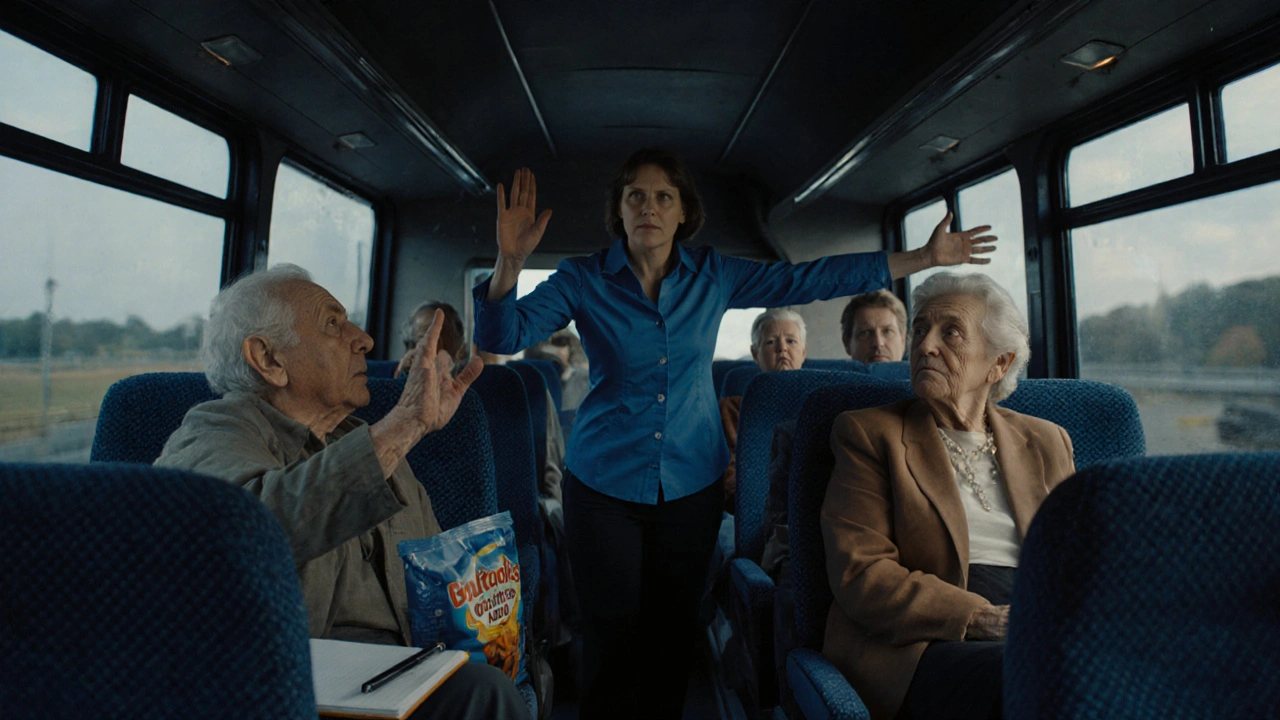Running a tour isn’t just about showing people landmarks. It’s about managing people - sometimes loudly, sometimes quietly, but always with intention. A group of 15 tourists from five different countries, each with their own expectations, tempers, and travel habits, can turn a smooth itinerary into a chaos zone in under an hour. One person complains the hotel is too far. Another insists on changing the lunch spot because they "don’t do spicy." Someone’s child is crying. Two seniors are arguing over who gets the front seat on the bus. And you? You’re the one holding it all together.
Why Group Dynamics Matter More Than Itinerary
Most new tour escorts focus on memorizing facts, timing bus departures, and checking off sights. But the real work happens off-script. The group’s energy, unspoken tensions, and hidden frustrations shape the experience more than any museum guidebook. A well-run tour doesn’t mean everyone’s happy - it means no one feels ignored, unheard, or unsafe.Studies in group psychology show that in small, high-stress environments like tours, conflict emerges fastest when roles are unclear, expectations are unspoken, and leadership feels inconsistent. Tour escorts who treat their role as a host, not just a guide, see fewer escalations and higher satisfaction scores.
Common Conflicts on Group Tours
Not all conflicts are the same. Here are the five most common ones you’ll face, and what’s really going on beneath the surface:- Time disagreements: "We’re leaving in five minutes!" vs. "I need 20 more minutes." This isn’t about punctuality - it’s about control. Some people feel anxious if they don’t dictate the pace. Others resent being rushed. The real issue: lack of shared rhythm.
- Food and dietary clashes: "Why are we eating this again?" or "I told you I’m vegan!" These aren’t just about taste. They’re about identity. People use food to express belonging, culture, or control. Ignoring dietary needs feels like dismissal.
- Seat and space battles: Who gets the window? Who sits with whom? These are about status, comfort, and social anxiety. Someone who’s introverted might dread being stuck next to a loud talker. A couple might want to sit together but can’t because the group didn’t coordinate.
- Photography delays: "Can we wait 10 more minutes? I need the perfect shot." This isn’t about photos. It’s about wanting to capture something meaningful. Rushing them feels like invalidating their experience.
- Group vs. individual needs: One person wants to skip the temple visit to rest. The rest want to go. This is the core tension: collective experience vs. individual autonomy.
Proven Conflict Resolution Strategies
You don’t need to be a therapist. You need clear, simple tools that work under pressure.1. Set the Tone Early - The First 15 Minutes Matter
The moment you meet the group, you’re already shaping dynamics. Don’t just hand out maps. Say this:"We’re all here for different reasons - some to relax, some to learn, some to escape. There’s no right way to do this tour. But here’s what I need from you: if something’s not working, tell me. Quietly. Right away. I can fix most things - but only if I know."
This does three things:
- Normalizes speaking up
- Removes shame from complaining
- Establishes you as a problem-solver, not an enforcer
2. Use the "Three-Second Rule" for Minor Annoyances
When someone complains about noise, pace, or food - don’t jump in. Wait three seconds. Often, someone else will respond. Maybe a quieter person says, "I get it, but I’m okay with this." Or a local traveler says, "In my country, we eat like this every day."Letting the group self-regulate builds cohesion. It also prevents you from becoming the only voice of authority - which makes you a target.
3. Offer Choices, Not Ultimatums
Instead of: "We’re eating at the restaurant at 1 p.m. No exceptions." Say: "We have two lunch options: Option A is the local seafood place everyone raves about. Option B is a quiet café with vegan and gluten-free choices. We’ll vote in five minutes - majority wins. If you need something else, let me know now and I’ll see if I can arrange it."This gives people agency. It turns opponents into participants. And if someone still hates the choice? They can’t blame you - they helped pick it.
4. Create "Quiet Zones" Within the Group
Not everyone wants to be friends. Some people just want to observe. Designate quiet spaces:- Let people sit in the back of the bus if they want silence
- Offer a 10-minute solo exploration window before reuniting
- Have a quiet signal - like a hand raised - for when someone needs space
This reduces resentment. People aren’t forced into social roles they didn’t sign up for.
5. De-escalate with Silence and Naming
When two people are yelling at each other over a missed turn, don’t shout over them. Walk between them. Pause. Say:"I hear you’re both frustrated. One of you is upset about being late. The other is upset about being blamed. That’s not fair to either of you. Let’s fix the problem, not each other."
Then, look at the person who spoke last and say: "Can you tell me what happened, just for me?"
People calm down when they feel heard - not when they’re told to calm down.

Tools Every Tour Escort Should Carry
You don’t need fancy gear. Just these three:- A small notebook: Jot down names, preferences, and complaints. Use it to remember who’s vegan, who hates stairs, who’s celebrating a birthday. People notice when you remember.
- A printed group list with contact numbers: In case someone wanders off or gets separated. Include a photo if possible - it helps locals identify them.
- A small stash of snacks and water: Not for everyone. Just for the person who’s crying in the corner because they missed their flight connection. Sometimes, a chocolate bar and silence fix more than a speech.
What Not to Do
Avoid these common mistakes - they make things worse:- Playing mediator between two tourists: Don’t take sides. Don’t say, "You’re right, he’s being rude." You’re not a judge. You’re a facilitator.
- Ignoring silent people: The quietest person is often the most stressed. Check in with them privately.
- Over-promising: "I’ll get you a private tour" or "I can change the hotel." If you can’t deliver, you lose trust.
- Using humor to shut down complaints: "Oh, you’re just being dramatic." That’s not funny. It’s dismissive.

When Conflict Escalates - What to Do
Sometimes, a situation goes beyond your control. A tourist becomes aggressive. Someone threatens to leave. A cultural misunderstanding turns hostile.Here’s your emergency protocol:
- Remove the person: "Let’s step outside for a minute. I want to understand what’s going on."
- Listen without defending: Don’t explain your actions. Don’t justify the itinerary. Just say, "Tell me what happened."
- Offer two real options: "We can continue tomorrow, or I can arrange a taxi to your hotel. You choose."
- Notify your company: Always report serious incidents. Don’t try to handle it alone.
Never escalate. Never shame. Never force. Your job isn’t to win - it’s to protect the experience for everyone else.
Why This Works - Real Stories
In Kyoto last spring, a German tourist refused to remove her shoes at a temple. The guide didn’t argue. She handed her a pair of disposable slippers from her bag - "For the floor. You keep your shoes on. No one will notice." The woman cried. Later, she thanked the escort for not making her feel stupid.In Rome, two sisters fought over who got to take photos first at the Colosseum. The escort said, "You both want to capture this moment. Let’s do it together. You take the first three shots. Then she takes three. Then we move on." They ended up taking a selfie together.
These aren’t miracles. They’re small, intentional choices.
Final Thought: You’re Not a Tour Guide. You’re a Group Healer.
Your job isn’t to make everyone happy. It’s to make sure no one feels broken by the trip. The best tours aren’t the ones with the most sights. They’re the ones where people leave feeling seen, respected, and a little less alone.Conflict isn’t a failure. It’s feedback. And you? You’re the one who turns that feedback into connection.
What’s the most common mistake tour escorts make when handling conflicts?
The most common mistake is trying to fix everything immediately. Tour escorts often jump in to solve a problem before understanding it. This can make people feel unheard. The best approach is to pause, listen, and let the group sometimes resolve things on their own. Your role isn’t to be the hero - it’s to be the calm center.
How do I handle a tourist who constantly complains?
Don’t label them as "the complainer." Instead, find out what they’re really worried about. Often, it’s fear of missing out, feeling ignored, or past bad experiences. Schedule a quick 5-minute chat after lunch. Ask: "What’s one thing that would make today better for you?" Then act on it if you can. People who complain loudly often just want to know they matter.
Should I allow tourists to change the itinerary?
You don’t have to say yes to every request - but you should always say, "Let me see what I can do." Small changes - like swapping a lunch spot or adding a 15-minute break - build trust. If you can’t change the schedule, explain why clearly: "The temple closes at 4, and we need to be there by 3:30 to avoid crowds." People accept limits if they understand the reason.
How do I deal with cultural misunderstandings?
Cultural clashes are inevitable. If someone is offended by a local custom - like not shaking hands or removing shoes - don’t defend the culture. Don’t dismiss their feelings. Say: "That’s a really important point. Let me explain why this is done here, and how we can respect both your comfort and the local tradition." Often, education + choice resolves it. Offer alternatives when possible.
What if a tourist becomes aggressive or threatening?
Your safety comes first. Stay calm. Do not engage in argument. Say: "I need to call my office for help." Then step away and contact your company immediately. If you’re in a public place, move to a crowded area. Never try to handle physical threats alone. Most companies have emergency protocols - know them before your first tour.
